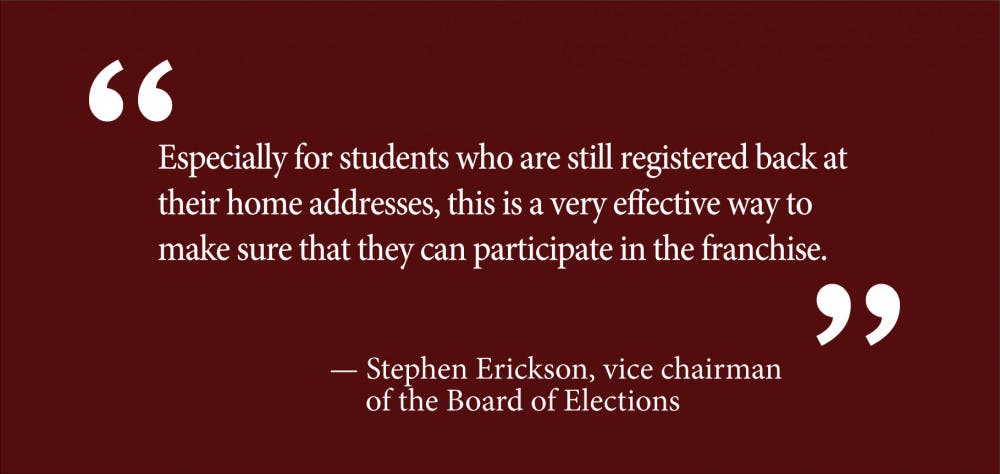Forty-one percent more voters applied for regular mail-in ballots in 2018 than in the 2014 gubernatorial election, the Rhode Island Board of Elections reported Tuesday. Since the last gubernatorial election, use of emergency mail-in ballots, which can be applied for up until the day before the election, has increased by 107 percent.
The Board of Elections attributes this spike to the allowance of “no-excuse” mail-in ballots. Prior to a 2012 policy change, Rhode Island required that voters provide justification to receive a mail-in ballot. Some of the limited excuses considered valid included illness or impairment of mobility, confinement to a hospital or nursing home or being temporarily absent from the state. Now, voters first send in a ballot application with a signature and mailing information, then receive their ballot in the mail.
Populations who may have trouble getting to the polls or being present on election day, such as those who work two jobs or lack access to reliable transportation, can more easily access voting via mail-in ballots, said Vice Chairman of the Board of Elections Stephen Erickson.
“A lot of campaigns have figured out that mail ballots are a way to ensure that populations that may have some difficulty getting to the poll have an opportunity to vote,” Erickson said. “When you tie together the mail ballots and what we’d like to see (from) early voting, what we’re doing is trying to expand the universe of ways in which people can make sure that they can exercise their franchise.”
Though the Board of Elections does not collect voter demographics, members suggested that Rhode Island natives who attend universities far from their home polling locations could benefit from the mail-in ballot.
“Especially for students who are still registered back at their home addresses, this is a very effective way to make sure that they can participate in the franchise,” Erickson said.
An Exeter, Rhode Island native, Brianna McFadden ’20 noted that her hometown’s polling station does not have a RIPTA line accessible from Brown. McFadden would have to rely on her father to drive her for 30 minutes to the polls without a mail-in ballot.
“I (used a mail-in ballot) in the 2016 election too,” McFadden said. “For me at least it was a pretty simple process.”
The Rhode Island Secretary of State’s office secured funding this year to pay the return postage for all mail-in ballots to decrease the strain on voters even further, said Robert Rapoza, executive director of the Board of Elections. The mail-in ballots can also prevent long wait times and extreme lines at the polling stations, especially if the ballot in question is lengthy, he added.
“We had one town two years ago that had over 40 referendum questions on the ballot,” Rapoza said. “If you weren’t prepared, you would be at that polling place a long time, and it would back up the voting because people are in the voting booth. What the town did was they mailed (mail-in ballot) applications and the questions to the voter encouraging them to do mail-in ballots.”
McFadden attested to lines as well: Even in a 6,000 person town at 6 a.m., when she went to vote at the primaries in high school, the line was long. Not by “Providence standards,” she said, “but for me it was kind of a long line. Like, ‘I hope to get to school on time.’”
But mail-in ballots pose their own difficulties. Voters must also be sure to correctly fill out the ballot envelope, which asks voters to include their own signature along with the signature of either two witnesses or a notary, said Miguel Nunez, deputy director of elections. In 2014, almost 1,100 ballots were voided because of a problem with these parameters.
“We’ve had notaries notarize non-existent signatures,” Rapoza said. Some voters forget witness or notary signatures, and others still submit mail-in ballots with signatures on the ballot itself that do not match the application for the ballot.
“It was very clear in a number of cases that somebody’s parent had signed the application to send the ballot to school somewhere,” Erickson said. “That’s a no-no. Make sure you sign your own ballot application.”
New 2018 rules and regulations institutionalize a process that returns faulty ballots to voters and gives them seven days to correct their ballot and return it before Nov. 6, Nunez said.
Officials tested the ballot correction process during the September primaries, but the Board of Elections reported that few voters took advantage of the opportunity. Two hundred thirty-eight voters were alerted of the need to fix their ballot, and the Board of Elections received 13 back.
The Board of Elections made multiple other efforts to facilitate voter participation and reduce wait times at polling stations. During the primaries, each precinct used one DS-200, an electronic machine that tabulates paper ballots. The most heavily populated precincts will have two or in rare cases three machines for the general election. To expedite voter check-in, the Board of Elections also deployed electronic poll books in place of paper ones. Nunez said that 131 field technicians will also work on election day — a 323 percent increase in field technicians used since 2014 — to ensure that increased dependence on technology will not go awry.





